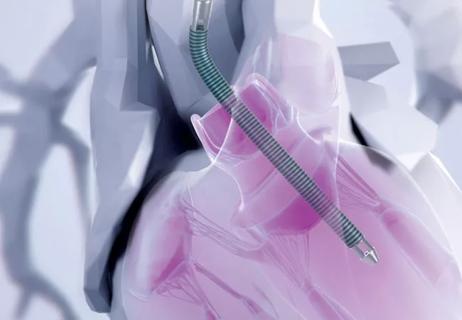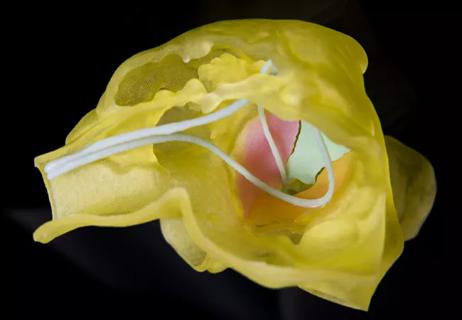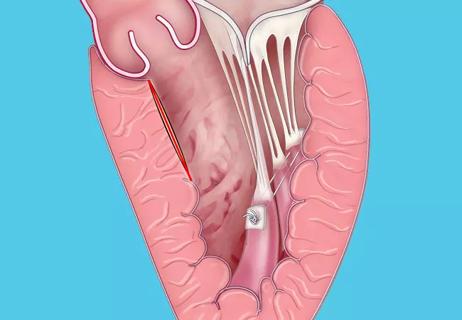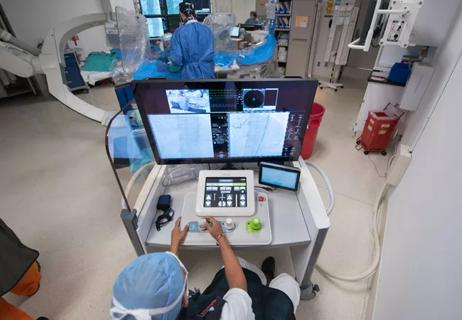Advertisement
Novel technique opens arteries and expedites healing

A multidisciplinary team of dedicated wound-care specialists at Cleveland Clinic takes a “no holds barred” approach to the treatment of complex, nonhealing wounds. By employing novel techniques for limb salvage and new products to encourage wound healing, they are often able to prevent or delay the need for amputation in the sickest patients (see example case study here).
Advertisement
Cleveland Clinic is a non-profit academic medical center. Advertising on our site helps support our mission. We do not endorse non-Cleveland Clinic products or services. Policy
“When others decide amputation is the only option, that is the patient we want to see,” says Mehdi Shishehbor, DO, an interventional cardiologist and Director of Endovascular Services in Cleveland Clinic’s Heart & Vascular Institute.
Dr. Shishehbor and vascular podiatrist Michael Maier, DPM, Director of the Lower Extremity Wound Clinic in the Department of Cardiovascular Medicine, evaluate patients together and formulate treatment plans for healing the wound and revascularizing the limb.
“There is no wait for consultative services,” says Dr. Maier. “If a patient has tissue loss, the sooner we restore blood flow, the better the chance the patient will heal.”
The vast majority of wounds treated at Cleveland Clinic are large, deep wounds complicated by infection and poor circulation. For successful healing, contributory factors must be treated aggressively and thoroughly. The treatment plan often involves specialists in other disciplines.
“What differentiates our wound care program is the breadth and depth of experts who are committed to these challenging patients,” says Dr. Shishehbor. The team includes key colleagues in vascular surgery, infectious disease, diabetology, nutrition, plastic surgery, and foot and ankle surgery, as well as orthotists and prosthetists.
Advertisement
Patients with peripheral arterial disease constitute 90 percent of Cleveland Clinic’s lower extremity wound care population. The remaining 10 percent generally have venous insufficiency or both conditions.
Due to the severity of ischemia typically encountered, the wound care team offers a variety of approaches to restore blood flow. These include endovascular treatment with angioplasty and stenting, bypass surgery and a novel technique known as combined antegrade-retrograde tibiopedal reconstruction.
“The optimal procedure depends on the severity and location of blockages and is not necessarily an either/or decision,” says vascular surgeon Lee Kirksey, MD, referring to stenting and bypass surgery. “Sometimes a hybrid approach, which involves using a balloon in one leg and performing bypass surgery in the other, can produce the most durable result and is less stressful than a larger operation.”
When a total obstruction cannot be crossed with a wire using a conventional antegrade approach, and the patient is too high-risk or not a candidate for bypass surgery, a retrograde approach via the foot arteries often achieves perfusion and can prevent amputation. Dr. Shishehbor is one of a handful of U.S. physicians skilled in performing combined antegrade-retrograde tibiopedal reconstruction.
Using a micropuncture needle, he accesses the small tibial or pedal arteries in the lower leg or the foot and introduces very low-profile wires (the same ones used to treat blockages in the heart) into the vessels. Multiple wire exchanges may be needed. A support catheter is introduced into the lumen and the lesion is crossed in the retrograde fashion. The intervention is then performed using femoral access.
Advertisement
“About 30 percent of patients cannot be treated with the typical antegrade approach. Using the combined antegraderetrograde approach increases the success rate to 93 percent,” says Dr. Shishehbor, who teaches the technique nationally and internationally. He, Dr. Maier and other Cleveland Clinic colleagues recently published positive early results with this approach in patients with high-risk critical limb ischemia.
Sophisticated nonsurgical treatments include the use of advanced wound-care products containing local mediators of wound healing and synthetic skin grafts.
“If we improve circulation and cure infection, but cytokines and other local mediators of wound healing have been depleted, healing is rare,” explains Dr. Kirksey. “So we replenish the extracellular matrix with a product that restores proteins and growth factors.”
Synthetic skin grafts made from porcine tissue and human cells are used to regenerate tissue and encourage healing of large wounds. (See clevelandclinic.org/skingraft for a short video of Dr. Kirksey applying one of the many types of synthetic skin graft products to a wound patient.)
When amputation is the most appropriate treatment, it must be performed properly. “The patient should be able to be fitted with a prosthetic and resume a meaningful life,” says Dr. Kirksey.
After a partial amputation, orthotists ensure the foot will bear weight when fitted with an appropriate shoe.
Amputation leaves a patient with a large wound that often requires assistance in healing. A post-acute team of physicians and nurse practitioners follows patients to skilled nursing and rehabilitation facilities after discharge to monitor healing in these settings.
When the healing process starts in the hospital, it continues in the ambulatory setting. For patient convenience, Cleveland Clinic offers wound care and ongoing treatment of underlying factors, including diabetes, obesity and cardiovascular disease, in its community hospitals.
“We can’t simply hope a wound will heal,” says Dr. Kirksey. “We must continue to be aggressive and diligent, or 60-day readmission rates can be as high as 35 percent.”
“If we do a complex intervention, and the patient has poorly controlled diabetes or blood pressure, the vessels will reocclude in short order,” says Dr. Maier. “The goal of treatment is ongoing management of cardiovascular risk factors and surveillance of peripheral arterial disease.”
Advertisement
“We are in it for the long haul,” he adds.
Dr. Shishehbor has received industry funding for two research projects: $500,000 to evaluate the impact of the platelet aggregation inhibitor ticagrelor (Brilinta®) on microcirculation in the foot, and $25,000 to test a novel microperfusion assessment tool currently used in breast reduction and gastric bypass surgery.
“We hope the tool will allow us to better assess whether a patient needs revascularization and whether a revascularization was successful,” he says. “Right now, tools to evaluate perfusion at the level of the foot are limited. We still have a lot to learn.”
Join us April 17-19, 2016, at the Cleveland Clinic Masters’ Approach to Critical Limb Ischemia Symposium.
Advertisement
Advertisement

Patient-patient network analysis proves to be fast and clinically intuitive

How we’re using a new multidisciplinary approach to broaden the benefits of ablation

Models developed with promising accuracy and generalizability to clinical practice

Illustrated case series profiles a valuable tool for a rare and complex entity

Keys to success include a team-based approach and integration into clinical workflow

A minimally invasive, single-incision approach to two coexisting problems

New review outlines applications to date, hurdles to overcome

A long-overdue technology is poised to reshape practice